06.09.2007, 11:28
Task:
Position the monitor, keyboard, mouse, USB port at a distance of 6-7 meters from the system unit. Please do not ask questions like “Why?” or "Why?" - it’s just necessary. :oops:
Given:
1.Monitor - VGA Acer AL2216W
1a. Video card GF-7950GT 512 PCI-E
2. Keyboard, mouse - Logitech cordless USB-PS/2 kit (at a distance of more than 4 m the reception is not stable, and even if it is stable, the batteries run out very quickly)
3. USB - USB 2.0 Hub D-Link DUB-CR200 (active)
3a. Mother - ASUS P5HW-Delux
Need to know:
1. The maximum possible length of the VGA cable, which allows you to receive an undistorted signal.
2. The maximum possible length of the PS/2 cable.
3. The maximum possible length of the USB cable.
4. If the lengths of certain cables do not allow reaching a length of 6 meters, what methods exist to amplify the signal and, accordingly, increase the maximum distance.
Thanks in advance, Victor!
06.09.2007, 11:33
VGA - like up to 1.5 m - if I'm not confusing anything
USB - up to 10 m - no questions asked
PS/2 - up to 5 m will work - but will have to be extended.
06.09.2007, 11:52
It's funny: the numbers vary monstrously! :oops:
I spoke with several IT people I know, and the info is this:
VGA - up to 10 meters without problems
- USB - up to 2 meters regular cable, up to 3.5 shielded, up to 6 meters with double screen, for longer lengths it is recommended to use some kind of cable with an amplifier (though I still don’t understand what it is). Two out of three respondents said that they encountered glitches via USB at a length of over 4 meters
- PS/2 - no one said anything.
06.09.2007, 13:39
Viktor M, I know that VGA on 10m can work without distortion, but this requires a high-quality cable. I saw a discussion somewhere on the Internet, there were even links to long VGA cables (5, 7 and even 10m). Unfortunately, now I probably won’t find that forum anymore... And anyway, it was in the States.
We need to look in our stores, I think you can find such cables somewhere.
Via USB - if possible, then with a good cable. A friend's USB printer worked for 6 meters, but not more. Alternatively, you can put an active USB hub somewhere in the middle (I don’t understand, did you plan your D-Link specifically for this, or for something else?). But at the same time, there should be a socket nearby (220V) where this hub will be plugged in.
I don't know about PS/2... :oops: Use USB if PS/2 won't work at such distances.
06.09.2007, 14:55
Andrewju, thanks for the tip! vosmilie:
After rummaging around on the Internet, I came across an office that deals with cables, located at 78 Vernadsky Avenue, p. 8:
Http://www.colan.ru/prices/level2n.php?id_group=5131
So after the negotiations the situation is like this:
VGA cable - range up to 10m, cost 7.5m - 650 RUR, 10m - about 1000 RUR
- USB cable- indeed, there are passive cables - up to 5 meters, above 5 meters you need to use active cables, their length is strictly 5 meters, and up to 10 pieces can be connected in series. The cost of such a cable is about 500 rubles.
- PS/2 cable - range up to 10 meters, cost 7.5 m - about 200 rubles.
Thanks to all!!! vosmilie:
06.09.2007, 15:26
Victor M, good luck! Let me know later if everything works and how it feels! vosmilie:
06.09.2007, 17:25
Hello YOU!
Viktor M, VGA - range 10m + standard cable. Works.
USB (5+amp, 5+amp) - 10 m keyboard+mouse. Works.
Over 5 meters it is necessary to use active cables, their length is strictly 5 meters, and up to 10 pieces can be connected in series. 10 pieces are STRONG! 2 extension cords of the same manufacturer. Not everyone can even pull 10 m, dead and all. We looked through it for a long time and chose, I don’t remember, which manufacturer. If I really need to, I’ll take a photo tomorrow, I’m in a mess.
andrewju, I agree with Andrey, PS/2 is not stable.
Agree, you need to discuss the possibility of a return, leave a deposit and go ahead for testing. There may be a story that on the “floor” (threw a point-to-point extension cord), it works. I laid it behind the ceiling and was dead!
We took everything on Gorbushka and Savelovsky, more than 1.5-2 years.
Good luck.
But so far there are simply no monitors on the market that support this interface. What is there? This article will talk about the main modern interfaces for connecting monitors and TV panels, their features and differences, and also give advice on how to choose a connection interface for specific needs and not make a mistake.
Note: the picture before the cat shows the connection panel for the Dell UltraSharp U2711 monster monitor.
Brief educational program
All existing interfaces differ from each other in three main parameters: the type of transmitted signal (analog or digital), the maximum supported resolution and throughput. Of course, there are many more parameters, but these three give a basic understanding of what a particular interface can do.In the competition between analog and digital interfaces, the latter have long won a convincing victory. The digital signal reaches the output device without much distortion, which allows you to get a high-quality picture without interference. In addition, any modern video card initially outputs only digital signal, and its conversion to analog - and on the monitor, unless, of course, we are talking about cathode-ray antiques, again to digital - leads to a significant loss of quality. However, analogue connections today still have their place in the sun.
When it comes to bandwidth and resolution, these two parameters are closely related. The greater the bandwidth provided by the interface, the greater the maximum image resolution. If someone does not understand what we now mean by the term “bandwidth,” then we explain: this is the number of bytes of information that the interface is capable of transmitting to the monitor per second after receiving a signal. It is obvious that interfaces designed to support the operation of wide-format monitors and LCD/plasma TVs with their high resolutions must have high bandwidth.
4K2K, 3D content and how to play it
Before we start talking about the actual ways to connect monitors and TVs, I would like to touch on a fashionable and current topic: ultra-high resolutions and 3D in consumer electronics.4K2K is a modern standard that implies a resolution of 3880x2160 pixels - four frames of 1920x1080, a standard that has long ruled the roost among high-definition video. Accordingly, each uncompressed frame requires four times the video interface bandwidth. And if you take into account the fashion for 48 FPS and 3D video... (multiply by two and by two more if you want 48 frames for each eye, and even in 3D).
Firstly, 4K2K content now is a big deal. Therefore, it will be difficult to enjoy anything other than the demo videos that come with your expensive TV in native resolution. To do this, many manufacturers install a special chip that allows you to stretch FullHD content to 4K2K using special algorithms: perhaps not as cool as 4K2K live broadcast, but very, very good for upscale. Ask any GT user who has such a TV - they won’t let you lie.
Secondly, there are two types of 3D different types- with passive and active glasses. In the first case, the content receives interlaced scanning, and polarized glasses, inertia, bright picture and an interesting movie makes you forget that half-frames come with an “unfair” resolution. In the second case, a double frame rate is used, and here the main problem awaits us: not all video interfaces are capable of transmitting a FullHD image with 48 frames per second.
Modern connection methods
We should start our review of the main interfaces used with VGA. This is the oldest of the popular interface types used today - it was developed back in 1987. Since then, however, it has been somewhat improved following the development of monitors.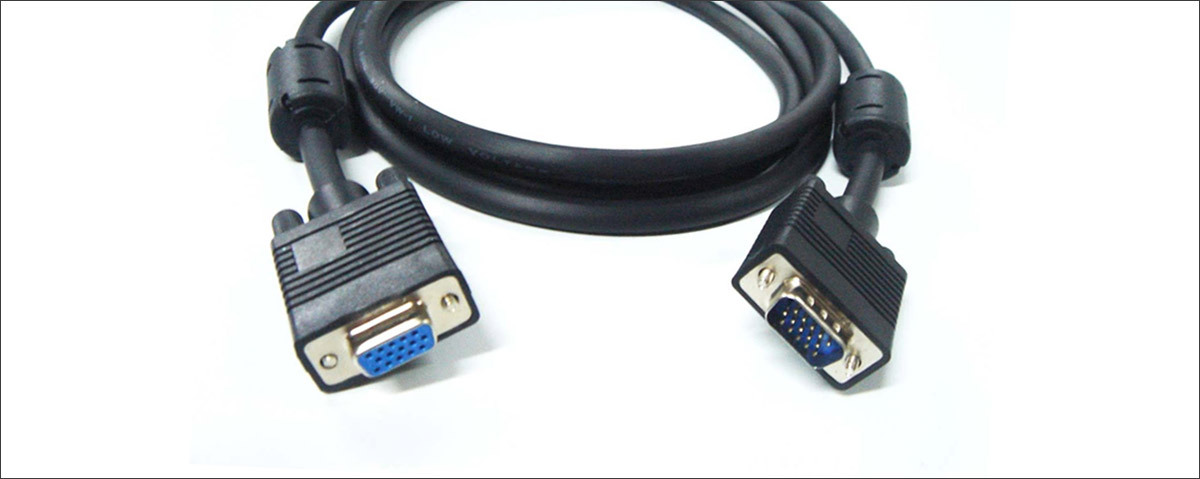
This is the only analog interface that is still actively used today - its “colleagues” S-Video, YP b P r and digital-to-analog SCART are no longer found in new modern devices. Almost all major computer manufacturers plan to completely abandon VGA this year. In essence, it simply has no advantages compared to other types - it is a morally and technically outdated standard that is about to disappear from the market. The maximum supported resolution is 1280x1024 pixels. Most often found in office monitors and various projectors.
The most popular digital interfaces today are DVI and HDMI.
DVI exists in three varieties: DVI-D (digital signal only), DVI-A (analog only) and DVI-I (both signal types). This interface provides good quality images, built into almost everything modern monitors and video cards. Its disadvantage is the strong dependence of the signal quality on the cable length.

Optimal data transfer via DVI is ensured by cables up to 10 meters long, which is sometimes not enough (however, for use in stationary home computers this is usually sufficient). The maximum supported resolution is 1920x1080 for single-channel and 2560x1600 for dual-channel models.

HDMI- a more modern and developed alternative to DVI. Unlike its “younger brother”, it can transmit not only video, but also sound signals, therefore, connectors of this type are available on all wide-format monitors with built-in speakers, projectors, and plasmas. Please note that when “docking” different versions HDMI the final set of functionality will correspond to the older one.

Here, by the way, lies a serious disadvantage of HDMI - many older cables are not marked in any way, and many features (in particular, 3D support) of HDMI versions 1.4 and older simply will not work, since the cable can easily turn out to be outdated. For the interface to work correctly, it is necessary to combine the versions of all three connection elements (input, cable, output), otherwise the throughput of the “lowest” element will be similar to a bottleneck. In conclusion, we note that, like DVI, HDMI suffers from insufficient recommended cable length (up to 5 meters).
Of the more modern interfaces, the first thing that attracts attention is DisplayPort. This type of connection was developed in 2006 and was planned as a replacement for DVI (but not HDMI, since these interfaces are aimed at different market segments).
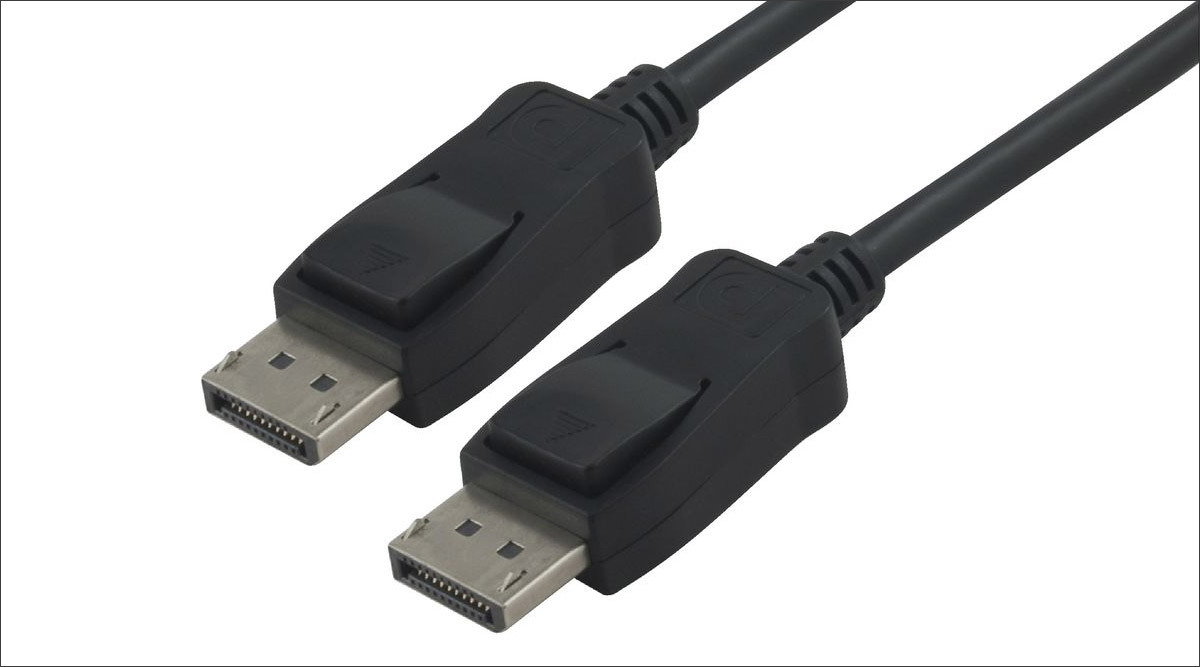
The latest versions (1.2 and 1.3, which is just beginning to gain popularity) support FullHD 3D mode and ultra-high resolution 4K2K, provide the highest data transfer speeds, allow you to connect professional screens with 48-bit color, and also provide a double level of protection for the transmitted content. What’s important is that DisplayPort allows you to connect entire chains of monitors to one connector using MutiStream technology, without loss of picture quality.

The maximum cable length is limited to three meters for full resolution and 10–15 meters for FullHD.
VGA, DVI, HDMI and now DisplayPort are the base of interfaces for connecting monitors and TVs today. However, there are also less common options, among which the most notable product is Apple and Intel - universal port Thunderbolt and the latest high speed USB version- 3.1 with Type-C connectors.
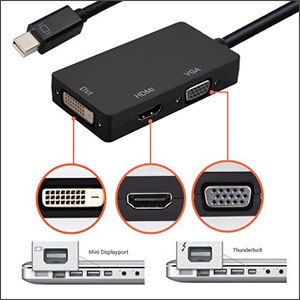 Thunderbolt- a connection interface that combines DisplayPort and PCI-Express connectors within one connector. Data transfer speeds are very high - 10 gigabits/sec for the first generation and 20 gigabits/sec for the second. The video signal is transmitted via TV using DP protocols - accordingly, like DisplayPort, Thunderbolt is capable of providing 4K2K resolution (in a MacPro using TV you can connect three monitors with this resolution at once), 3D support and in general everything that they can latest versions D.P. By the way, recently announced monitors with a resolution of up to 5120×2880 are planned to be equipped with Thunderbolt. Both generations of the interface are fully compatible with each other and with other interfaces using adapters.
Thunderbolt- a connection interface that combines DisplayPort and PCI-Express connectors within one connector. Data transfer speeds are very high - 10 gigabits/sec for the first generation and 20 gigabits/sec for the second. The video signal is transmitted via TV using DP protocols - accordingly, like DisplayPort, Thunderbolt is capable of providing 4K2K resolution (in a MacPro using TV you can connect three monitors with this resolution at once), 3D support and in general everything that they can latest versions D.P. By the way, recently announced monitors with a resolution of up to 5120×2880 are planned to be equipped with Thunderbolt. Both generations of the interface are fully compatible with each other and with other interfaces using adapters.
In general, Thunderbolt looks like an extremely promising universal peripheral interface, with its characteristics capable of meeting all the needs of top-end monitors and the latest TVs. So far, however, its prevalence in gadgets leaves much to be desired.
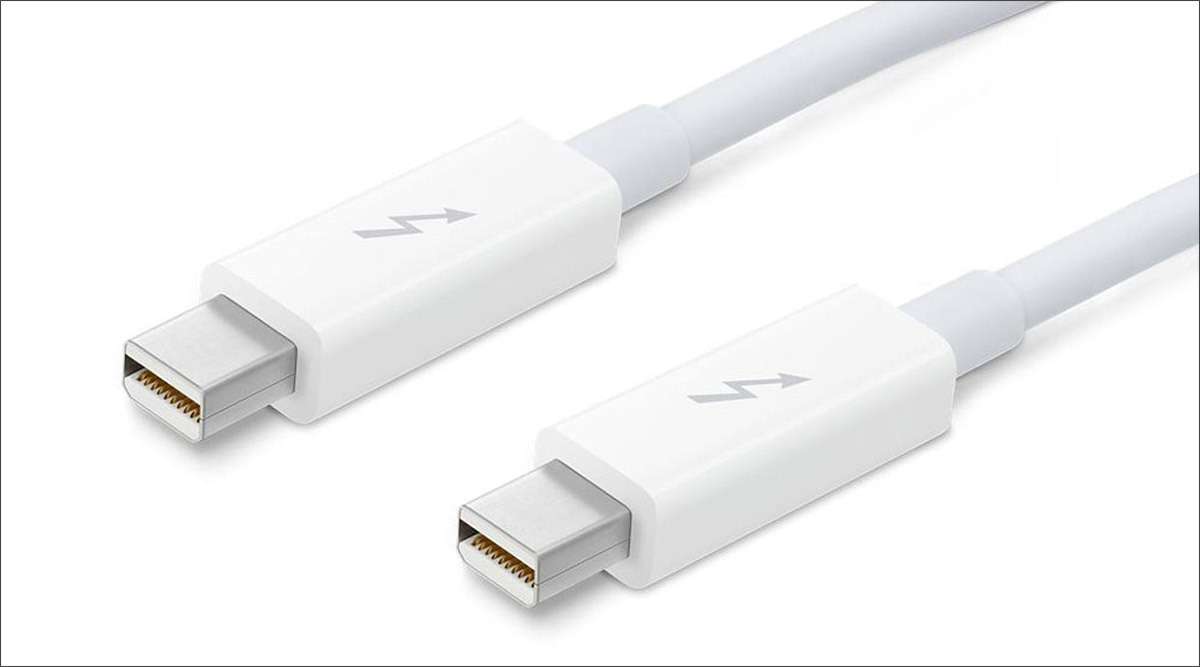
The maximum cable length is 20 meters, however, such a wire costs about five hundred dollars, supports only the second version of the protocol and contains both copper lines and optical fiber. Cables of more standard sizes - two and three meters - cost quite reasonable money.
Screen without wires
Modern technologies make it possible to provide an excellent picture on a monitor or TV without wired connection. If your monitor or TV supports wireless data transfer, you may want to consider this option. From the software that ensures the monitor operates according to wireless network, usually ordinary users hear three standards - Miracast, DLNA and WiDi. No wonder, they are the most popular at the moment. Let's go over them now.Miracast- the most common standard for wireless data transmission using Wi-Fi. Unlike many competitors, it does not require a buffer device - transmission is carried out directly, which is extremely convenient. Another important advantage is that the transfer occurs not in files, but in packets of raw data. Miracast is relatively “young”, but more than 500 manufacturing companies are already implementing it into their devices, which gives the right to consider it almost universal. The maximum supported resolution is 1920×1200 pixels. Of course, by modern standards this is not much, but for wireless transmission- the best option.
DLNA (Digital Living Network Alliance)- a very widespread technology for transmitting data over a wireless network. It is integrated into many smartphones, modern televisions, laptops and even game consoles. Allows you to freely transfer data between devices connected to a single network, including, of course, transmitting video from devices to screens. A serious disadvantage of DLNA is the specific supported encoding standards - the program almost always starts transcoding before playback, which wastes time and device resources.
WiDi (Intel Wireless Display)- developed by Intel, it is, if possible, an analogue of DLNA. The product is very easy to set up, making it ideal for creating home theater or storing a movie collection. The main disadvantage is that many note a noticeable signal delay, which makes WiDi a poor choice for games on a large screen.
How to choose an interface to connect to
The choice of an interface for connecting a monitor or TV to a computer should always be based on your needs and goals - as well as the choice of any accessory and components for digital equipment in general. Ask yourself what you need. Do you intend to watch movies on a widescreen monitor? high quality? Work with 3D graphics? Or do you not run anything heavier than Word on your computer at all, and all you need from the picture on the monitor is for it to be there?It’s clear that even if you have VGA connectors on your video card and monitor/TV next to some digital interface, you don’t need to take cables for the analog standard. VGA is almost history, leave it to live out where it still exists: in projectors and the worst models of monitors. Focus only on digital interfaces.
The vast majority of current devices have connectors for DVI and HDMI, and top models also have DisplayPort, so you will have to choose first of all from these three. The basic advice is this: to output a signal to desktop monitors not in ultra-high resolution, DVI is sufficient, but to play it on a plasma, projector, Blu-ray player, etc. It is worth using HDMI, since in addition to video it can also transmit other data (sound, special subtitles, and so on). DisplayPort puts DVI and HDMI on both sides in terms of image transmission capabilities, but for now it remains the domain of professional and semi-professional equipment. In addition, there are problems with sound output: not all equipment supports audio/video interconnect technology. Its closest relative, Thunderbolt, can do even more: transfer not only a picture, but also, say, a USB hub.
Brief reminder
VGA: supports a maximum resolution of 1280x1024 pixels, cannot do Full HD, not to mention 3D, is only suitable for use on the simplest office computer or projector. And yes, it is morally outdated.DVI: built into literally every modern video card and monitor, which is its huge advantage. Available in single- and dual-channel versions, differing in maximum resolution (1920×1080 and 2560×1600, respectively). Supports digital and analog signals depending on the variety (DVI-A for analog, DVI-D for digital and DVI-I for both). Suitable if you want to play and watch movies on a large, good monitor. There are technologies for connecting 4K2K screens with two cables, so it’s too early to throw DVI into the dustbin of history.
HDMI: An ideal choice for connecting a TV to a receiver, computer or laptop, as it also transmits audio signals and some types of subtitles. Available in almost any modern reproducing technology. Supports FullHD 3D, maximum resolution 3840x2160 (4K2K), up to 32 audio channels. Current version– 2.0. To create a home theater, feel free to choose HDMI.
DisplayPort: This standard It is superior to “consumer” HDMI in almost everything, but for now it remains the lot of professionals and geeks. There are simply no inexpensive monitor models with DisplayPort. If you are a designer or modeller, then this is your choice, since this interface not only has high bandwidth and supports 4K2K and Full HD 3D, but also allows you to connect several monitors in a single chain without loss of quality, which is convenient if you have a laptop, and additional connectors don't bet on it. The latest DP version is 1.3, but the most common connectors and wires are version 1.2.
Thunderbolt: On this moment This is also more of a professional interface than a mass one. The most important advantage is full compatibility with DP and data transmission using its own protocol. Thunderbolt can be recommended primarily to users
What connectors are there on video cards?
To connect monitors, VGA and DVI connectors are installed on video cards; to connect other video devices, the following can be used: RCA (composite) video output, S-Video, HDMI output. Interfaces VGA, RCA, S-Video - analog, DVI and HDMI - digital. The quality of the video signal and, accordingly, the price of the video card depend on the type of supported interfaces.
Digital video interface for connecting LCD monitors, projectors, TVs, plasma panels. Provides undistorted video signal transmission, since the image is transmitted directly from the video card of a PC or laptop, without double digital-to-analog conversion that occurs when using analog interfaces, such as S-Video or composite video. The maximum cable length is 5 meters.
Interface types:
DVI-D - The 24-pin connector only supports digital interface.
DVI-I - The 29-pin connector includes both a digital interface and an analog (VGA) interface, which uses an additional 5 pins. A monitor with an analog VGA connector is connected via a special adapter.
The analog S-Video connector provides noticeably better image quality than composite video and is widely used in household and semi-professional equipment.
Color and brightness signals are transmitted over separate wires, and a picture with a resolution of 400-500 lines can be obtained. It must be remembered that the wiring of this mini-DIN connector on ATI and NVIDIA cards is different. The maximum cable length is 5-300 meters.
Modern video cards may use other mini-DIN connector options, such as a 7-pin combined video output (both S-Video and composite inputs and outputs are available).
InterfaceHDMI ( High Definition Multimedia Interface)
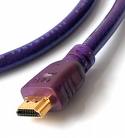 |
This multimedia interface present in latest video cards and home multimedia centers. home HDMI feature- the ability to transmit audio and video over one cable: high-definition digital video signal (HDTV - resolution up to 1920x1080 pixels), multi-channel digital audio, as well as control signals. HDMI allows you to get rid of a bunch of wires and make do with just one. The maximum cable length is three times higher than that of DVI - 15 meters.
The image resolution of standard television is 720x480 pixels for the NTSC system and 720x576 pixels for the PAL system. Standard resolutions for HDMI are 1920x1080 and 1280x720. Various digital audio formats are supported (up to Dolby Digital 5.1).
What is HDCP?
This is a content protection technology used in HDMI and DVI. HDCP(High-bandwidth Digital Content Protection, developed by Intel) - encrypts the transmitted signal and requires a decoder on the receiver - monitor, TV or projector. Recording devices, such as DVD recorders, cannot decode and, accordingly, record such a signal.
